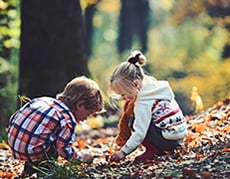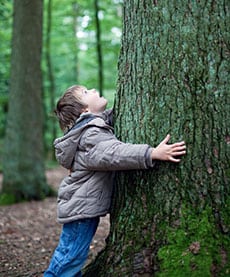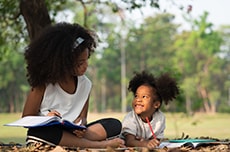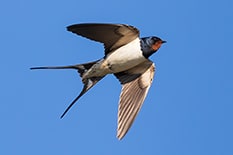
by NIAS | Oct 1, 2023 | Family Activity
Fall is an excellent time to learn about deciduous trees, such as oak trees and maple trees. A good activity for the family is to learn about the life cycle of an oak tree. Find an oak forest and start exploring and observing.
During autumn, deciduous trees start to lose their leaves, preparing for the dormant period of winter. Spend a few minutes underneath the trees and wait for some leaves and acorns to fall (watch out!). They are falling because now is the time for the seed to land on the ground and become covered by snow. The seeds will overwinter and upon spring, the little plant will emerge from the seed ready to become a mighty oak someday.
Examine an acorn for herbivore activity by looking for small holes. The acorn may have a tiny insect larvae inside, using the seed for nutrients. Or, watch squirrels scurry around, collecting acorns, also relying on the seed for food.
Also examine the leaves for herbivore activity. You may notice small bumps called galls, which the plant produces in response to insect larvae. Also take notice of the color change within the leaf – the green chlorophyll has likely disappeared, leaving red, orange, or yellow pigments to remain.
Finally, lay down in the bed of leaves and make a “leaf angel” similar to a snow angel in the winter! Using your senses, listen to the crunching sounds of the leaves and smell the scents of autumn.
Harvest Decorations
A fun activity you can do with your family and friends is decorating pumpkins. Each person can pick out their favorite color paints, and use them to paint their own pumpkin!
An easy craft that you can do in the fall is to make a pinecone birdfeeder! All you need is a pinecone, peanut butter, bird seed, and string. First, spread the peanut butter on the pinecone, then roll it in birdseed so the birdseed sticks to the peanut butter. Next, tie the string around the top of the pinecone and hang it from a tree.
Leaf Fun
There are many leaves strewn on the ground: pick one up and ask your children to find another leaf that is the same color the same shape. This seems simple, but many kids group all leaves together and may have never noticed the different shapes.
Put your hand on a tree and ask your kids to find a similar tree. Ask your kids to notice the texture of the bark or the shape of the leaves. It isn’t necessary that they identify the tree as oak or maple, just encourage them to notice that all bark is not the same and not all leaves aren’t the same shape.
Then, depending on the ages of the kids, you may want to do some simple tree identification. But the most important thing with this is just to notice differences.
Have your kids collect some leaves and have each one choose a favorite. Have the child observe that leaf closely. Take that leaf and choose another 3 or 4 leaves for this game. Have the child stand in front of you with hands behind their back. Set a leaf in the child’s hand and have them examine the leaf with their fingers.
Is this their favorite leaf? Try one leaf after another until the child identifies the favorite leaf by touch alone. Can they tell you what the identifying feature was? If there are several kids, they can pair up to play the game.
Have your kids collect as many leaves as they can in 15 seconds. Clear a spot on the ground and have the kids sort the leaves into whatever groupings they would like – can group by size, shape, color, insect damage or whatever works in that setting.
Autumn Scavenger Hunt of the Senses
Make a list or, better yet, a chart with picture:
- To Find: pine cone, acorn, red leaf, apple, twig, feather (and any other color leaf or any item to add)
- To Look For: Spider web, a leaf falling to the ground, clouds, a bug
- To Listen For: Leaves under feet, wind in trees, chipmunks and squirrels scampering through leaves, calls of birds of fall/winter – bluejays, crows, chickadees, etc.
- To Smell: pine, cedar, a fall flower, decomposing leaves
Then go home, have some hot chocolate and talk about your findings.

by NIAS | Sep 1, 2023 | Family Activity
What do birds eat and how do they eat it?
Look at some bird pictures and point out the beaks, explaining that every bird has a beak that is shaped to help it hunt and eat its own food. Then you can try out these techniques:
Eat like a robin: Embed gummy worms in a cake pan full of packing noodles. Have the child try to spear the gummy worms with tweezers.
Eat like a hummingbird: Have the child suck up a little sugar water, using a straw for a beak and fitting the straw through a hole in a piece of paper or foil covering a glass.
Eat like a cardinal: Use a nutcracker to crack sunflower seeds or something of similar hardness. Point out the wide, strong beak of the cardinal. Perhaps you can make a beak that is like that of a cardinal.
Eat like a woodpecker: Help a child peck hard at an old piece of wood with a screwdriver or other hard, pointed object; you can keep your hand over the child’s to prevent a drilled thumb or finger. You can put Cheerios on the other side and draw those out to show that the woodpecker has successfully found the insects. Roll a small piece of paper into a funnel shape and coat it with a little honey to show the long, sticky tongue that is going to pull out the Cheerios.
Eat like a flycatcher: Put a cheerio on a string and have the child perch on an ottoman or small chair and try to snatch the cheerio as you swing it by. Then, have him “fly” after the insect/cheerio as you whisk it around the room.
Eat like a finch: Put some Rice Krispies in a small cardboard box with holes in it; have him get the krispies with tweezers.
Eat like a chickadee/sparrow, etc.: Put the cheerios in a bowl and let him eat – no hands allowed.
Eat like an eagle, hawk, etc.: Let the child pounce on a small stuffed animal – you can add the sharp or hooked beak and talons when the child is old enough not to be frightened by that aspect. According to the age of the child, you can show the various kinds of woodpeckers, flycatchers, finches, etc.
Meet a Tree!
Touch a tree; rub your cheek on the bark. Is it rough or smooth?
Is this tree alive?
Can you put your arms around it?
Is it older than you are?
Can you find plants growing on it?
Do you see or hear any birds in the tree?
Any squirrels?
From Sharing Nature with Children, Joseph Cornell
Trees as Habitats
What are some plants and animals that depend on trees?
What do trees provide for these plants and animals?
Can you see signs of life on the trunk, branches, roots, and leaves?
How is a tree affected by the plants and animals that live on it?
From Project Learning Tree, Forest Foundation
Attract Hummingbirds
Hang a hummingbird feeder in a spot where you can easily see it. Since hummingbirds are territorial, you might want to hang two, one in front and one in back.
Food: 1 part sugar to 4 parts water. Boil the water to kill bacteria or mold. Add the ¼ cup sugar to 1 cup water. Cool. Excess mixture can be saved for up to two weeks in the refrigerator.
Do not add food coloring, honey (it ferments), or sweetener.
Clean at least once a week, more often if water gets cloudy. To clean, use 1 part white vinegar to 4 parts water: rinse 3 times to make sure all vinegar is gone. If mold develops, clean with a 10% bleach solution and rinse several times.
Water will keep out ants; many feeders have water containers on top.
Flowers with bright, rich colors are most likely to attract hummingbirds; long or tapered shapes help to accommodate the long bills. Native species are preferred. Some flowers that are likely to attract hummingbirds are bee balm, cardinal flower, zinnia, salvia, bleeding heart, lupine, columbine.
You can make your own feeders with tall, narrow bottles and feeding tubes, which come 12 to a pack.
With simple hand lenses, explore in minute detail such wonders of nature as the hairs on leaves or the intricacies of flower parts.
Match nature’s colors: Put crayon, marker or colored pencil color markings on index cards and match with findings in nature. How many shades of green and brown can you find? Can you find all colors of the rainbow?
Summer Outdoors
Many ideas for summer fun for kids and their families in Summer Activities: Nature Activities for Children, by Irmagard Kutsch, Brigitte Walden (illus.).
On a rainy day, go outside during or after a rain to listen, smell, touch and see its effects. Ideas from Listen to the Rain, by Bill Martin Jr. and John Archambault.
If it is raining, would you describe it as soft and slow, roaring and pouring, hurly-burly, topsy-turvy, ligihtning-flashing, thunder clapping, sounding pounding roaring or dripping.
- Can you see raindrops of different sizes?
- Can you find any animals moving during or after a rain? Which ones?
- Which plants still hold some rain drops in certain places? Where?
- What can you smell after a rain?

by NIAS | Jul 1, 2023 | Family Activity
Family Activity
Go insect hunting!
Insects are the most successful animals on the planet. They are amazing! They are the first organisms to fly! They can buzz! They can jump! They can sting! They have beautiful colors! Some even light up!
Learn about these creatures in your own backyard. To attract them, put something like banana out in an area outside. Spread the banana on a rock or bark of a tree for a short period of time. Check it regularly and see who has visited. With an adult, go out at night with a flashlight to see if there are different insects at nighttime.
Carefully catch an insect and look at it with a magnifying glass. (ask an adult first – some insects and spiders do bite or sting.) How many legs do you count? If you count six legs, three body regions, and two antennae – it is an insect. If you count eight legs, two body regions, and no antennae, it is likely a spider, which is not an insect! If there are too many legs to count, it could be a millipede or centipede!
If you want to watch an insect for a short period of time, place it in a jar with some sticks, leaves, and a little cap of water. Cover with a net or waxed paper with holes poked through. Return the insect back home within 24 hours or less!
Learn that insects are not here to harm you and you should not harm them. Teach others not to use pesticides in their lawns, not to use bug zappers, and also to turn off unnecessary lights at night. All of these kill, hurt, or confuse insects. Insects are important for the ecosystem and without them, we would also be harmed.
Explore the Colors of Nature
First, take pieces of strong paper or index cards and color them with different crayons, markers, or colored pencils. Take these cards outside and match them with what you can find in nature. How many different shades of green can you find? How many different shades of brown can you find? Can you find the colors of the rainbow?
Remember to look high and low! At this time of year, many flowers are blooming with different shades of color but don’t forget to look at what could be on or in the flower. The diversity of insects that visit the flowers is endless!
Observe the diversity of birds. Many birds appear one color, but at different angles, show a variety of other colors. For example, the Common Grackle may at first appear all black, but when the light strikes just right, you can see an iridescent rainbow. The male Ruby-throated hummingbird has a red throat at some angles, but it appears black at other angles. Other birds show their colors when their wings open – just wait and be patient and you might be able to see them show off their hidden colors!
For younger children, take a large piece of cardboard and make multiple circles, each with a different color outline. Ask your child to find loose items in nature and place them in the correct circle. This will incorporate early sorting skills, counting, and improve dexterity.
These activities are a great way for kids (and adults) to look closely and pay attention to what they are seeing.
Make your own Stained-Glass Planet Earth
Look up a picture of planet earth and notice that it is made up of more water than it is land. Sometimes we even call it planet ocean instead of planet earth!
On a sheet of paper, use crayons (and not markers or colored pencils) to color a picture of earth and all of the oceans. When done, turn your paper over. Then use a cotton ball dipped in a very small amount of vegetable oil and rub over the back side of your paper. The paper will turn transparent and the colors will come through. Allow the paper to dry. Then hang up your “Planet Ocean” in front of a window so light can shine through.
Another idea is to use clear contact paper and tissue paper. Cut out your earth and ocean pieces from different colors of tissue paper and place them on one sticky side of the contact paper. Cover with another piece of contact paper. Now you have a stained-glass earth to hang in front of a window.
Idea modified from dltk-kids.com

by NIAS | Jun 1, 2023 | Beginning Birder
Barn Swallow (Hirundo rustica)
Swallows are a group of birds known for their small beaks that are suitable for catching insects in flight. Swallows are fun to watch as they glide quickly through the air, gobbling up many insects. The Barn Swallow is the most abundant and widely distributed swallow species throughout the world. Because they are insect eaters, they must migrate to warmer areas when winter approaches, such as South and Central America to maintain their food supply. They will return north to breed.
They are iridescent blue on the upper side of the body and orange-brown on the underside of the body. They are unique from the other swallow species with their deeply forked tail. They also fly lower than other swallows when foraging for prey. They can fly so low to the water that they can contact the water and even take a drink.
As the name suggests, they are often found in barn areas, but also found in many other habitats like open fields, wetlands, and other aquatic habitats. For breeding, they require open areas and human-made structures, such as eaves, rafters, barn supports, and bridges for building their nests. Both males and females collect mud, mix it with grass, and build a cup nest together that is about 3 inches across and 2 inches deep. They may often reuse the nests after cleaning out old feathers and adding new mud.
While Barn Swallows are not likely to visit your bird feeder, you can go visit them in their common habitats. Enjoy their fast and aerodynamic flights and try to identify them if you can! To help swallow populations, learn about the effect of pesticides on the food web. They require insects for their diets, so killing insects will harm insectivores. Additionally, if you fish, discard of fishing line properly so birds do not get tangled in the lines.
* Thanks to allaboutbirds.org.

by NIAS | Jun 1, 2023 | Family Activity
Family Activity
Although it may be summer vacation, it is always a good time to learn new things. This summer, make a nature journal with members of your family and/or friends. Get a small notebook for everyone that can easily be carried with you on your nature adventures. Date your entry and note the time. Also note whether it is sunny or cloudy or rainy or snowy. If you come back to the same location at a later time, it’s fun to compare how things have changed and what different things you experienced. It’s also enjoyable to compare your drawings and what you learned with others.
There are many ways to do your entries!
1) Use your senses! You could find a peaceful spot and just sit, watch, and listen. Jot down anything you see, hear and/or smell. If a child cannot write, they can try to draw the object or animal.
2) Go insect-collecting! First, always use caution for any biting or stinging animals that you might encounter. Use an insect net and catch some insects! Pick up stones and see what is underneath. Carefully place any insect in clear containers with air holes to observe then for a short amount of time. Draw them and describe them in your notebook. Release the insect when done.
3) Go Bird-watching! Have a pair of binoculars and also use your sense of hearing. You will hear many species of birds before you actually see them. Learn their songs and calls and then try to identify the bird. When you see a bird, note the size, beak shape, color, tail size and shape, presence of wing bars, and any behavior. See if you can determine if they are male or female. Write down and draw all of the birds you see. Come back another day and see if the same birds are around. This will help you also learn about which species migrate and which species do not.
4) Look for leaves and flowers! First, it would be important that you do not touch any plant unless you are certain of what it is. There are some plants that cause itching and irritation as well as blisters if you touch the sap. Walk around and look at the different flowers and leaves of plants and trees that you see. Draw them and if you identify the plant as safe, do a leaf rubbing in your notebook. If you come back another time, note whether you see the same flowers or not.
Save your journals and reflect on them later, especially in a different season. When you may be missing some of the birds or greenery in the winter, you can enjoy your drawings!
Get Outside!
A fun adventure to go on with friends or family is to take a bike ride! Go for a ride in a park, around the neighborhood, or on a bike path nearby. Bike rides are a good way to have fun with friends and family outside while getting a little exercise!
Take a family trip out to Elkhorn Creek Biodiversity Preserve on July 27 between 1 – 5 p.m. to join us at our annual butterfly festival! At this festival, participants can join guides on butterfly tours, or look for butterflies on their own.
One fun activity to do in order to cool down this summer is to make popsicles! All you will need is a container (either small cups, an ice cube tray, or a popsicle tray), your favorite juice, and popsicle sticks. Pour your juice into your container of choice, then put your container safely into the freezer. Keep an eye on your popsicle, and when the juice is half frozen, stick the popsicle stick in until frozen completely. Take your popsicle out of the freezer and container, then enjoy with friends and family outside!
Summer Outdoors
Many ideas for summer fun for kids and their families in Summer Activities: Nature Activities for Children, by Irmagard Kutsch, Brigitte Walden (illus.).
On a rainy day, go outside during or after a rain to listen, smell, touch and see its effects. Ideas from Listen to the Rain, by Bill Martin Jr. and John Archambault.
If it is raining, would you describe it as soft and slow, roaring and pouring, hurly-burly, topsy-turvy, ligihtning-flashing, thunder clapping, sounding pounding roaring or dripping.
- Can you see raindrops of different sizes?
- Can you find any animals moving during or after a rain? Which ones?
- Which plants still hold some rain drops in certain places? Where?
- What can you smell after a rain?





